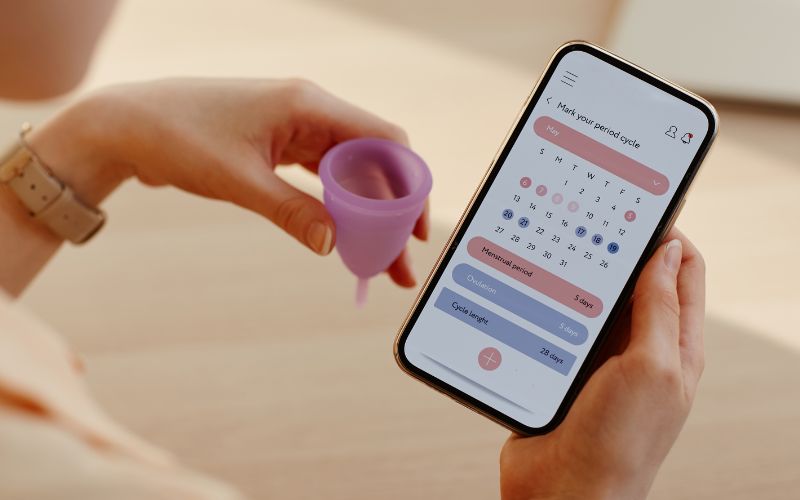What is cycle syncing? How does cycle syncing benefit me? Should I exercise while cycle syncing? Does cycle syncing help with hormonal imbalance? If you have these questions and more, this article is for you.
Hi, I am Katie Lister, a practicing Registered Nurse and the founder of Growth Gals. I lead personal development groups and communities and coach women to become the best versions of themselves. GG provides women with a safe space to come together to learn and get support from like-minded women. This article will provide the information you need to know about cycle syncing. Its benefits, and how to apply it to your life.
Table of Contents

Katie Lister
What is Cycle Syncing?
Cycle syncing is a method women use to adapt their lifestyle to fit the phases of their menstrual cycle. The term was first coined, by Alisa Vitti, a nutritionist and hormones expert, in her 2014 book- Woman Code. Vitti also created the app MyFlo and founded the FloLiving Hormone Center. The method entails adjusting your exercise and eating habits based on your menstrual cycle, which helps to stabilize any hormonal imbalances.
According to a study, hormonal fluctuations in a woman’s monthly cycle significantly affect her body’s responses. The fluctuations affect her thought processes, appetite, emotional status, sex drive, and more. Women in this study reported high levels of self-esteem and well-being in the middle of the cycle. Just before that time of the month, they reported feeling anxious, depressed, and hostile.
The Cycle Syncing Method Explained
To understand the cycle syncing method, you must understand the menstrual cycle. From a recent study on the length of the menstrual cycle, a regular cycle lasts, on average, twenty to twenty-nine days and has four phases.
Menstruation (Early follicular phase)
The early follicular phase is the first phase of the menstrual cycle, lasting between three and seven days. The phase involves the shedding of the uterine lining or endometrium. In this phase, you have low estrogen and progesterone levels, which makes you feel bloated and tired.
Late Follicular phase
The late follicular phase of your menstrual cycle lasts fourteen to twenty-one days. It involves new follicle growth in the ovaries. Your estrogen levels increase, improving your energy and mood levels.
Ovulatory phase (Mid-Luteal)
The third phase of the menstrual cycle lasts between one and two days when the ovaries release an egg (ovulation). Your progesterone and estrogen levels are at their highest, boosting libido, energy, and mood.
Late Luteal phase
The final phase is the late luteal, and if you are not pregnant, your body prepares for another menstrual cycle. Your progesterone levels rise and cause symptoms like breast tenderness, bloating, and mood swings.
Each phase has specific hormonal changes that affect your physical and mental health. Knowing the hormonal changes in each phase, you can now adapt your fitness and diet to suit the cycle.

The Benefits of Syncing Your Cycle
Experts say that cycle syncing provides several benefits, such as:
- Feeling more energized
- Balancing hormones and fewer mood swings. Cycle syncing helps you better understand your body and support yourself during the menstrual cycle.
- A better and more effective exercise routine
- It helps with fertility and with knowing the best time to conceive. However, cycle syncing may not be effective for women using hormonal contraceptives like the patch, birth control pill, IUD, etc.
- Reduces Premenstrual Syndrome (PMS) symptoms such as cravings, mood swings, and bloating
- Reduces injury risks during workouts
- Better sleep quality
What Foods are Ideal for Syncing The Cycle?
We have discussed the hormonal fluctuations you will experience in the different phases of your cycle. Cycle syncing food is one of the best ways of managing hormonal fluctuations during your cycle. As a beginner, you can enlist the help of a nutritionist who can help you plan your meals, talk to your doctor, and get a fitness instructor to guide your fitness journey.
Foods to eat during the Menstrual phase (early follicular)
During this phase, your magnesium and iron levels are low, contributing to PMS symptoms like bloating, cramps, and poor sleep quality. Eat magnesium and iron-rich foods like:
- Flaxseeds
- Sweet potato
- Proteins (beef, chicken, fish, and eggs)
- Leafy greens
- Pumpkin seeds
- Ginger tea
- Nuts
- Whole grain
Foods to eat during the late follicular phase
In this phase, eat protein-rich foods for muscle repair and growth. Include enough fiber to support your body’s estrogen metabolism. The stress hormone cortisol may also increase in this phase. Some of the best follicular phase foods to lower stress include:
- Dark chocolate
- Citrus fruits for Vitamin C
- Berries
- Avocados
- Pumpkin and flaxseed
- Nuts
- Salmon
- Olive oil
- Broccoli
Reduce your sugar, caffeine, and alcohol intake during this phase.
Foods to eat during the ovulation phase
At the peak of your estrogen levels, you need to consume anti-inflammatory foods with a lot of vitamin D and B. Eat the following:
- Chia seeds
- Flaxseed and pumpkin seeds
- Almonds
- Legumes
- Lean proteins
- Eggs
- Tomatoes
- Quinoa
- Leafy greens
- Fruits (papaya and citrus)
- Whole grains (pasta, bread and rice)
Food to eat during your luteal phase
Serotonin transmits messages between your brain and body and regulates emotions. In the second half of your menstrual cycle, serotonin levels decrease, leaving you feeling depressed and anxious. Your progesterone levels also rise, causing PMS symptoms such as mood swings, breast tenderness, and bloating. If your egg does not fertilize, your body prepares to shed the endometrium.
One of the best ways to manage these symptoms is by choosing the right luteal phase foods. Serotonin and mood booster foods include:
- Fruits(Apples and berries)
- Proteins
- Spinach
- Seeds
- Foods with omega-3 fatty acids, like salmon
- Dark chocolate
- Seeds (sesame)
Ideal Exercises for Syncing Your Cycle
Cycle syncing workouts allows you to be in tune with your body and give your body what it needs through each phase. Here are some things to remember during each phase to sync your fitness routine.
Exercise cycle syncing during the menstrual phase
Your energy levels are low during the menstrual phase. Avoid high-intensity workouts and take the time to rest and do low-impact exercises like:
- Light cardio like hiking and walking
- Light yoga poses
- Stretches
These guidelines only work for some women. Others feel energized from the second day of their cycle. Modify your workouts according to your body type and needs.

Exercise cycle syncing during the follicular phase
Your energy levels are rising, so you can increase your workout intensity. You can include these workouts during the follicular phase:
- HIIT (high-intensity interval training)
- Strength training
- Running
- Swimming
- Boxing
- Hiking
Exercise cycle syncing during the ovulation phase
Your energy levels are high due to increased testosterone, and you should take advantage. Do not overdo the exercising, as it might decrease your sex hormones, reducing your fertility levels. Include these workouts during this phase:
- HIIT (High-intensity interval training)
- Running
- Boxing
- Cycling
- Circuit training
Exercise cycle syncing during the luteal phase
As your progesterone spikes, your energy levels dip and you start to feel tired after ovulation. Continue with strength training and low-impact exercises like:
- Pilates
- Yoga
- Cardio (low intensity)
Factors That Can Make Syncing Your Cycle Difficult
Cycle syncing may become difficult for some women due to varying factors such as:
Hormonal imbalance
Hormonal imbalance causes irregular periods.
In a regular cycle, the menstrual period lasts between four to seven days and recurs approximately every 28 days.
On the other hand, an irregular period is characterized by:
- Periods occurring over thirty-five days apart or fewer than twenty-one days
- Missing your period two or three times in a row
- Heavier or lighter menstrual period than normal
Some health conditions that cause irregular periods include:
- Endometriosis
- Polycystic ovary syndrome (PCOS)
- Pelvic inflammatory disease (PID)
Stress
Stress can affect your menstrual cycle by making your body produce more progesterone and shortening the luteal phase. Stressful jobs or intense physical stress leads to changes in the cycle and can lead to cycles with no ovulation.
Weight and BMI
If you are overweight with a BMI of 25 to 30 or obese with a BMI of over 30, you may have frequent cycles with no ovulation phase. This is because estrogen, stored in fat, prevents ovulation. Underweight women (BMI less than 20, have low body fat, and their bodies cannot keep estrogen, affecting menstruation.
Change in time zones
Traveling is stressful and exhausting. It can cause ovulation postponement or failure, especially when traveling through different time zones. The change in time zones causes your internal clock to stop running synchronously.
Does Cycle Syncing Help with Weight Loss?
A recent study shows that when premenopausal women tailor their exercise and eating habits around their cycle, they can lose more weight. Below is how you can use cycle syncing to lose weight.
Early Follicular Phase (From Day 1 to 4)
Your energy levels are at their lowest, and you should do light exercises like walking, yoga, or stretching. Your appetite is mellow, so adjust your eating to match your energy. You might feel fuller with fewer snacks and small food portions.
Late Follicular Phase (From Day 5 to 15)
As your energy increases, you should increase the intensity and frequency of your workout. As your hunger spikes, add more proteins to your meals.
Luteal Phase (From day 16-28)
You have more energy and crave more energy-dense meals. Increase your workout intensity and frequency. Add extra calories to your diet, but ensure they come from healthy fats (nuts, olive oil, and avocados) and proteins, not carbohydrates. In the last four days of the cycle, satisfy any cravings by eating some dark chocolate.

How Do You Sync Your Cycle With An Irregular Cycle?
The female body is complex, and there is no miracle to make your menstruation come on time. What may work for one woman may not work for the next. However, there are some hacks to help regulate your menstrual cycle as much as possible.
- Get a regular sleep, stress management, and exercise routine.
- Eat more cruciferous vegetables: Broccoli, kale, and other leafy greens to balance your hormones and eliminate estrogen.
- Incorporate fermented foods like tempeh and kimchi into your diet to increase good gut bacteria. These ferments balance a group of enzymes called estrobolome, which help metabolize estrogen in the intestines. A good estrogen balance helps to regulate your cycle.
- Eat more fiber: Fiber will help to keep your menstrual cycle regular. Research shows that food with a lot of fiber (berries, cruciferous vegetables, and whole grains) helps boost estrogen metabolism.
Cycle Syncing and Hormonal Balance
A pre-existing hormonal imbalance may be causing your irregular periods. Some women with more estrogen may have irregular periods. Progesterone is more critical in keeping your cycle on track, and any imbalance will lead to irregularity. Balance your hormones by:
Exercising
Polycystic Ovary Syndrome (PCOS) is a common hormonal imbalance causing irregular periods. Your ovaries produce excess amounts of a hormone called androgens, which delays or prevents ovulation.
Women living with PCOS can use cycle syncing to fine-tune their workout routines to counter the impact of their hormonal changes.
Taking supplements
While you can eat a balanced diet, you may have to take supplements to support your delicate hormonal balance. Some of the supplements may include but are not limited to:
- Magnesium eases PMS symptoms, reduces inflammation, improves insulin resistance, and supports better sleep.
- Vitamin B12: Produces red blood cells, thyroid hormones, and melatonin and regulates sex hormones. Vitamin B12 is found exclusively in animal meat. Thus, daily supplementation is crucial for vegans and vegetarians.
- Omega-3 fatty acids contain anti-inflammatory properties, which can alleviate symptoms of hormonal imbalances. Getting enough omega-3 fatty acids from your diet is not always possible, so supplementing is highly recommended.
Using a tracking app
Track your periods with a period-tracking app to familiarize yourself with each cycle phase.
Cycle Syncing: How Growth Gals Can Help
Our mission is to inspire women to reach their full potential and exceed their expectations. We aim to create positive change by giving women the resources to pursue their passions. Growth Gals helps women overcome obstacles, connect with others who have experience with cycle syncing, and live a healthy life.
If you would like to part of a supportive network of women, be sure you subscribe to our newsletter for the latest in personal development!
Conclusion
Cycle syncing can help you adapt your lifestyle to fit the phases of your cycle. There is enough research around cycle syncing to prove it reduces hormonal imbalance, improves fertility and mood swings, and has numerous other benefits. Tracking apps can help you track your period and better sync your cycle with your exercise and diet routines.
Joining a community like Growth Gals will help guide you on self-care and how to kick-start your cycle-syncing journey. Meet like-minded individuals who will offer a solid support system and help you understand how to cycle sync and more about women’s health.


